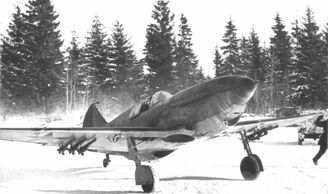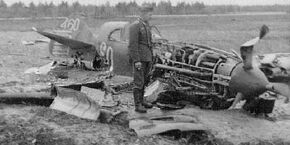
A LaGG-3 taking off with full rocket load out
The Lavochkin-Gorbunov-Gudkov LaGG-3 was a single-seat fighter that was used by the Soviet Union during World War II.
Description[]
The LaGG-3 had a liquid-cooled Klimov M-105PF engine that was capable of propelling it at speeds of up to 560 kilometers per hour. Operational range was around 650 kilometers while its service ceiling was around 9,700 meters. Rate of climb was 900 meters per minute. The armament of the LaGG consisted of a single 20mm ShVAK autocannon and two 7.62mm ShKAS machine guns. Secondary armament could consist of up to six rockets or four 50 kg bombs.[1] The total weight of the LaGG was around 2,600 kilograms while its total length was around 8.8 meters. The total wingspan was around 9.8 meters.[2] The reliability of the LaGG was fair, though it had several problems with power to rate ratio and engine reliability. While the LaGG-3 was thought to be able to hold its own and effectively combat contemporary German aircraft, by the time the first 109s engaged them in 1941, the LaGG was completely outclassed.
Another series of problems also arose with the handling characteristics of the early LaGGs with many suffering from severe problems with losing control of the aircraft. As a result, turning and using the elevator control suffered with the LaGG. However, this was later mostly corrected with the LaGG-3-66.
| “ | It was an unpleasant client! Preparing the LaGG-3 for flight demanded more time in comparison with other planes. All cylinders were supposed to be synchronized: God forbid you from shifting the gas distribution! We were strictly forbidden to touch the engine! But there were constant problems with water-cooled engines in winter: especially as there was no antifreeze liquid. You couldn't keep the engine running all night long, so you had to pour hot water into the cooling system in the morning. Furthermore, pilots didn't like flying the LaGG-3 - a heavy beast with a weak M-105 engine - but they got used to it. Even so, we had higher losses on LaGG-3 than on I-16s. - Viktor M. Sinaisky, A VVS Pilot | ” |
Made with a laminated wood air frame, the LaGG-3 was remarkable strong and as a result could take quite the punishment from enemy fire.
Variants[]
The LaGG-3 variants were divided into around 66 different series of about 100 examples produced in each. Typically, each of the series had numerous minor variations such as redesigns to the fuselage and engine. The most famous variant of the LaGG-3 series was the LaGG-3-66 or the final production series. Also notably produced was the LaGG-3-66IT with a 37mm autocannon mounted in the nose of the aircraft.

German personnel surrounding the crash site of a LaGG-3
Other variants of the LaGG were mostly prototype aircraft. However, the variant of the LaGG-3 that was truly the most successful and the definitive successor was the Lavochkin La-5, created by mounting a radial engine onto the air frame.
History[]
The LaGG-3 was initially developed in 1940 as a replacement to the short-lived LaGG-1. The initial prototype was designated the I-301 and was quickly put into service with the VVS. Naturally, the first combat operations that the LaGG-3 took part in were in mid 1941 during Operation Barbarossa in which the LaGG performed quite poorly. It was outclassed by the 109 and oftentimes strafed on the runway before it could take off. However, production continued on with later variants attempting to correct the critical issues with early production models. These worked somewhat but the LaGG-3 still had problems in the field.
Despite this, production of the LaGG-3 along with its major variant, the La-5 continued on into 1944 when the LaGG-3-66 was finally put out of all front line service. One notable case of a LaGG-3 being captured however was in 1942 with a LaGG-3 landing on a Chinese airfield and subsequently being seized by Japan. Later tests by Japan showed it to be inferior to their own A6M2 "Zero". In total, around 6,600 examples had been produced during the war, all following the 100 serie variant system.
References[]
| |||||||||||
